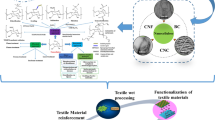Abstract
The use of immobilized enzymes during saccharification of lignocelluloses enables the continuous process of enzymatic hydrolysis and repeatable use of enzyme, resulting in reduced operational cost. Novel nano-biocarriers were developed by layer-by-layer deposition of carbon nanotube (CNT) on the foam structures, and their efficiency for enzyme immobilization was demonstrated with cellulase and β-glucosidase. A three-fold enhancement was achieved in the activity of cellulase immobilized on CNT coated polyurethane foam. In addition, both cellulase and β-glucosidase immobilized on the CNT-foam showed much better storage stability and operational stability than the ones immobilized on the commercial biocarrier (Celite), which is critical for a continuous operation. CNT coated monolith was also developed as a biocarrier, offering high surface area and geometric stability. These nano-biocarriers are promising candidates for the efficient saccharification of biomass and to reduce carbon footprint and cost of the equipment.








Similar content being viewed by others
References
Bakker M, van de Velde F, van Ranwijk F, Sheldon RA (2000) Highly efficient immobilization of glycosylated enzymes into polyurethane foams. Biotechnol Bioeng 70(3):342–348
Balasubramanian K, Burghard M (2006) Biosensors based on carbon nanotubes. Anal Bioanal Chem 385(3):452–468
Bryjak J (1995) Storage stabilization of enzyme-activity by poly(ethyleneimine) Bioproc Eng 13(4):177–181
Buchholz K, Klein J (1987) Methods in enzymology: immobilized enzymes and cells. Academic Press. London, pp 3–30
Chakrabarti AC, Storey KB (1988) Immobilization of cellulase using polyurethane foam. Appl Biochem Biotechnol 19(2):189–207
de Lathouder KM, van Benthem DTJ, Wallin SA, Mateo C, Lafuente RF, Guisan JM, Kapteijn F, Moulijn JA (2008) Polyethyleneimine (PEI) functionalized ceramic monoliths as enzyme carriers: preparation and performance. J Mol Catal B-Enzym 50(1):20–27
Dincer A, Telefoncu A (2007) Improving the stability of cellulase by immobilization on modified polyvinyl alcohol coated chitosan beads. J Mol Catal B-Enzym 45(1–2):10–14
Dincer A, Okutucu B, Zihnioglu F, Telefoncu A (2005) Immobilization of alpha-glucosidase in chitosan coated polygalacturonic acid. Prep Biochem Biotechnol 35(2):103–111
Haupt B, Neumann T, Wittemann A, Ballauff M (2005) Activity of enzymes immobilized in colloidal spherical polyelectrolyte brushes. Biomacromolecules 6(2):948–955
Lu J, Okeke B (2012) Process for whole cell saccharification of lignocelluloses to sugars using a dual bioreactor system. US Patent 8,143,040 B2
Lu J, Drzal LT, Worden RM, Lee I (2007) Simple fabrication of a highly sensitive glucose biosensor using enzymes immobilized in exfoliated graphite nanoplatelets Nafion membrane. Chem Mater 19(25):6240–6246
Lu J, Do I, Fukushima H, Lee I, Drzal LT (2010) Stable aqueous suspension and self-assembly of graphite nanoplatelets coated with various polyelectrolytes. J Nanomater 18:64–86
Mateo C, Abian O, Fernandez-Lafuente R, Guisan JM (2000) Reversible enzyme immobilization via a very strong and nondistorting ionic adsorption on support-polyethylenimine composites. Biotechnol Bioeng 68(1):98–105
Neumann T, Haupt B, Ballauff M (2004) High activity of enzymes immobilized in colloidal nanoreactors. Macromol Biosci 4(1):13–16
Pessela BCC, Betancor L, Lopez-Gallego F, Torres R, Dellamora-Ortiz GM, Alonso-Morales N, Fuentes M, Fernandez-Lafuente R, Guisan JM, Mateo C (2005) Increasing the binding strength of proteins to PEI coated supports by immobilizing at high ionic strength. Enzym Microb Technol 37(3):295–299
Sherigara BS, Kutner W, D’Souza F (2003) Electrocatalytic properties and sensor applications of fullerenes and carbon nanotubes. Electroanalysis 15(9):753–772
Taherzadeh MJ, Karimi K (2007) Enzyme-based hydrolysis processes for ethanol from lignocellulosic materials: a review. Bioresources 2(4):707–738
Tu MB, Zhang X, Kurabi A, Gilkes N, Mabee W, Saddler J (2006) Immobilization of beta-glucosidase on Eupergit C for lignocellulose hydrolysis. Biotechnol Lett 28(3):151–156
Tu MB, Chandra RP, Saddler JN (2007) Evaluating the distribution of cellulases and the recycling of free cellulases during the hydrolysis of lignocellulosic substrates. Biotechnol Prog 23(2):398–406
Vasudevan PT, Lopez-Cortes N, Caswell H, Reyes-Duarte D, Plou FJ, Ballesteros A, Como K, Thomson T (2004) A novel hydrophilic support, CoFoam, for enzyme immobilization. Biotechnol Lett 26(6):473–477
Acknowledgments
We would like to thank the funding support from the Department of Energy Small Business Innovation and Strategies Program (DE-FG02-07ER84872), the Michigan University Research Corridor (URC), and the Michigan Initiative for Innovation and Entrepreneurship.
Author information
Authors and Affiliations
Corresponding authors
Rights and permissions
About this article
Cite this article
Lu, J., Weerasiri, R.R. & Lee, I. Carbon nanotubes tuned foam structures as novel nanostructured biocarriers for lignocellulose hydrolysis. Biotechnol Lett 35, 181–188 (2013). https://doi.org/10.1007/s10529-012-1066-5
Received:
Accepted:
Published:
Issue Date:
DOI: https://doi.org/10.1007/s10529-012-1066-5




